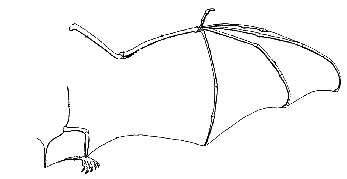
- - The skull of a bird is also very lightweight. It has a light, horny toothless beak that is composed primarily of the protein keratin. Since the bird's jaws have no teeth to support, the jaw can also be reduced in mass. The beak is a bird's primary tool and some are modified for digging, probing, piercing, chiseling, straining, cracking, pecking, etc.

-
2. In order for the flight muscles to deliver the power required to fly, a
bird has a very high metabolism; its body contains numerous large
air sacs; its circulatory and respiratory systems are extremely
efficient; and its digestive system is capable of processing large
amounts of food in a very short period of time.
- - Birds have a 4-chambered heart:The oxygenated and unoxygenated blood is kept completely separate. This would improve the efficiency with which tissues are oxygenated and cleansed of carbon dioxide.
- - The lungs are extensive and the fact that air is circulated both when the bird inhales and when it exhales allows rapid oxygenation of the tissues
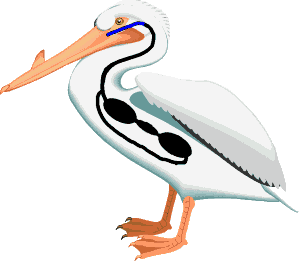
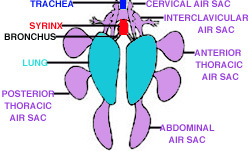
3. Urogenital Adaptations to reduce weight:
a. No urinary bladder or urethra - kidneys produce uric acid, excreted as semisolid paste so this also contributes to water conservation.
b. Only left ovary persists in most adult females
c. sex organs in both sexes are functional only during the breeding season; when breeding is complete, gonads regress.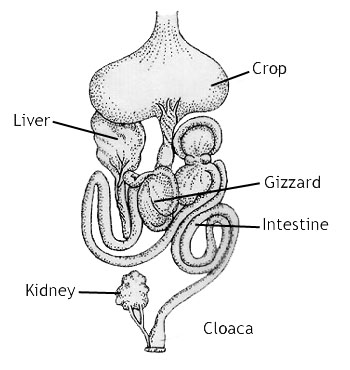
Lift = is caused by differential pressures on opposite sides of an airfoil (structure with convex top and flat or slightly concave bottom that tapers posteriorly)
Bird wings are airfoils. They work because as air passes over the wing, it must travel further over the upper surface than the lower surface. Thus, it must move faster on top than on bottom. The faster the air moves the lower the air pressure. Since the bottom has more pressure than the top, you get lift.
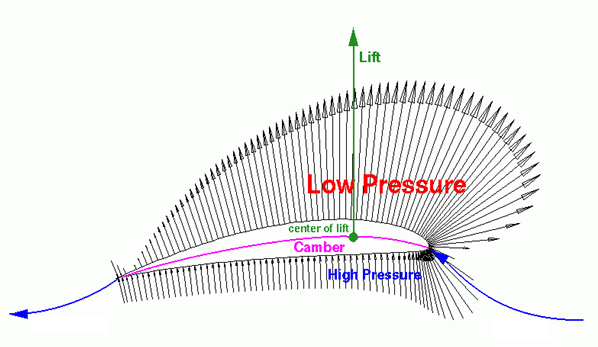
The angle of the wing (or airfoil) is important. A steeper angle relative to air flow results in increased distance across the top of the wing. This in turn increases the air speed, which decreases the pressure and results in greater lift.
But, too steep an angle produces turbulence that can result in stalling. Solution: Alula = feather attached to 1st digit (thumb), moves independently from rest of wing so can act as a wing slot and increase. lift.
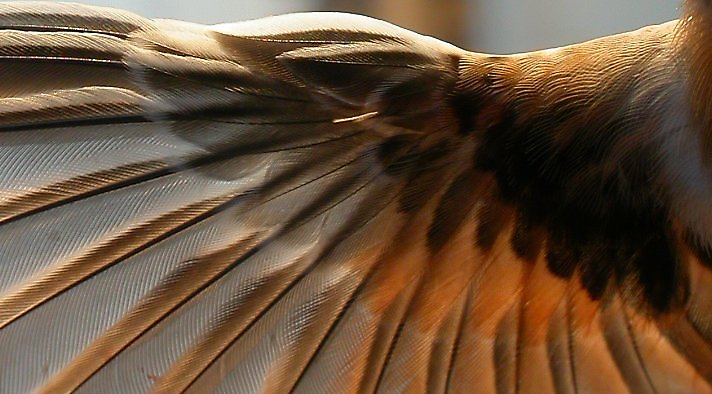
ADAPTIVE STRUCTURE OF WINGS
Wings can be classified into 4 types, each adapted for a different type of habitat and lifestyle.
- Elliptical = adapted for forest or shrub habitat where maneuvering is important. (Galliformes, many Passerines).
- High Speed = adapted for feeding on wing or very long- distance migration; flattish profile. [Shorebirds, Falcons, Hummers, Swallows, & Swifts].
- Long and narrow, adaptive for soaring (Pelagic birds.)
- High Lift = adapted for carrying heavy loads. Deep curvature (Hawks & Eagles, Cranes).
Evolution of Birds
Uncertainty about the origin of birds and their early evolution still exists, but fossil evidence is beginning to accumulate and what was once a very fuzzy picture is gradually becoming clearer.
The earliest true bird fossils are found in the late Jurassic, but there are possible footprints from early Jurassic and it seems likely that the bird lineage began to diverge from the theropod dinosaurs in the early Jurassic or late Triassic. The fossil record of birds is sketchy because the first birds were small (and so their fossils are hard to find) and their bones are thin and lightweight (and so dissentigrate rather than fossilize).
Brid evolution is deduced from a cladistic analysis of the living and fossil species. There are four steps:
1. The most likely ancestors of birds appear to be a branch of theropod dinosaurs. These were carnivorous and bipedal with a fairly upright posture. Because the forelimbs were not used in locomotion they could be modified for other purposes.
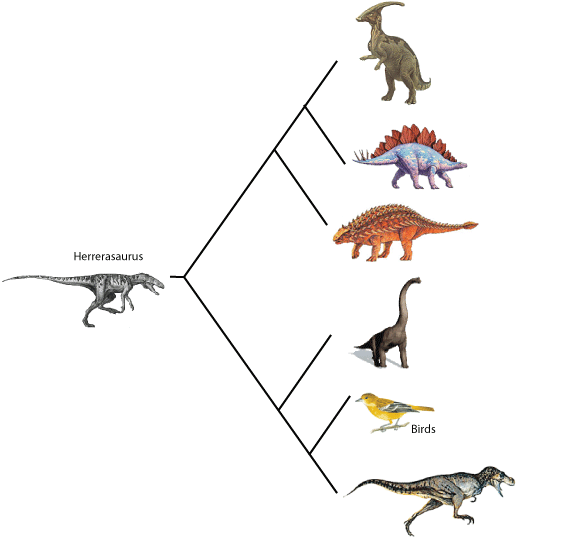
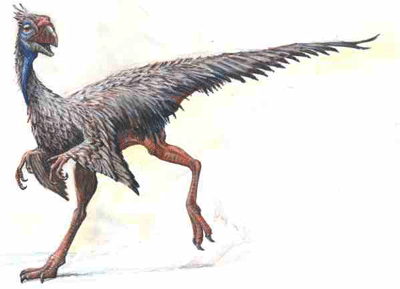
2. The Dromeosaurs are intermediates between birds and carnivorous dinosaurs, most are small (the size of a chicken).
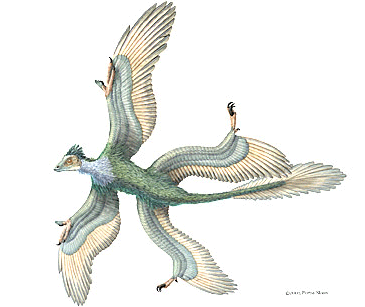
In most ways these are typical theropod dinosaurs - they have a tapering snout (not a beak) and teeth, and a long tail. But they also have modified forelarms - the wrist bones are fused as in a bird, and muscles to the arms are attached to fused collarbones (in other words, it has a wishbone). And they had feathers
At the end of the Cretaceous, bird fossils appear that are very similar to modern birds with the exception that they still have teeth. Many of these were shore birds and lived like modern gulls or loons - that is diving into the water to catch fish in their toothed beaks.
At the end of the Cretaceous, Pterosaurs and other Dinosaurs went extinct and in the subsequent period (known as the Tertiary) the modern major groups of birds arose. You don't need to know the modern birds, but here they are for your interest:
1. Ratites - large flightless birds (e.g., rhea, ostrich)
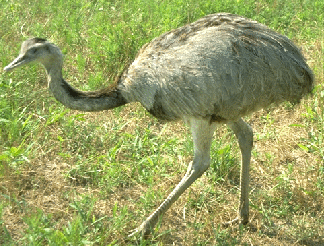
2. Passerine - perching birds (e.g., song birds)
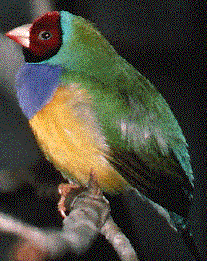
3. Galliformes - Game birds (e.g., chickens)
4. Waterfowl - (e.g., ducks, shorebirds)

5. Falconiformes - birds of prey (e.g., hawks)
The Three Solutions to Flight
Possibly the most amazing example of convergent evolution among vertebrates is the evolution of flight in three different vertebrate groups: Pterosauria (pterosaurs), Aves (birds), and Chiroptera (bats). Their similarieties are due to the physical constrains imposed by flight; their differences are due to their different ancestry.
1. The first vertebrates to evolve true flight were the pterosaurs. Pterosaurs were proficient flyers with a wing was supported by an elongated fourth digit. Pterosaurs had other morphological adaptations for flight as a keeled sternum for the attachment of flight muscles, a short and stout humerus (the upper arm bone), and hollow but strong limb and skull bones.
2. Birds have flight adaptations similar to those of pterosaurs: hollow but strong bones, keeled sternum for flight muscle attachment, and short and stout humeri. However, unlike the pterosaur wing, the bird wing is primarily supported by an elongated radius, ulna, and modified wrist bones (the carpometacarpus). Birds also have a structure that they share with their dinosaur ancestors: a fused clavicle (collarbone) called the furcula (wishbone), which serves as a brace during the flight stroke.
3. The bat wing is made of a membrane supported by the arm and the
greatly elongated fingers
